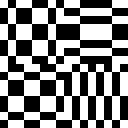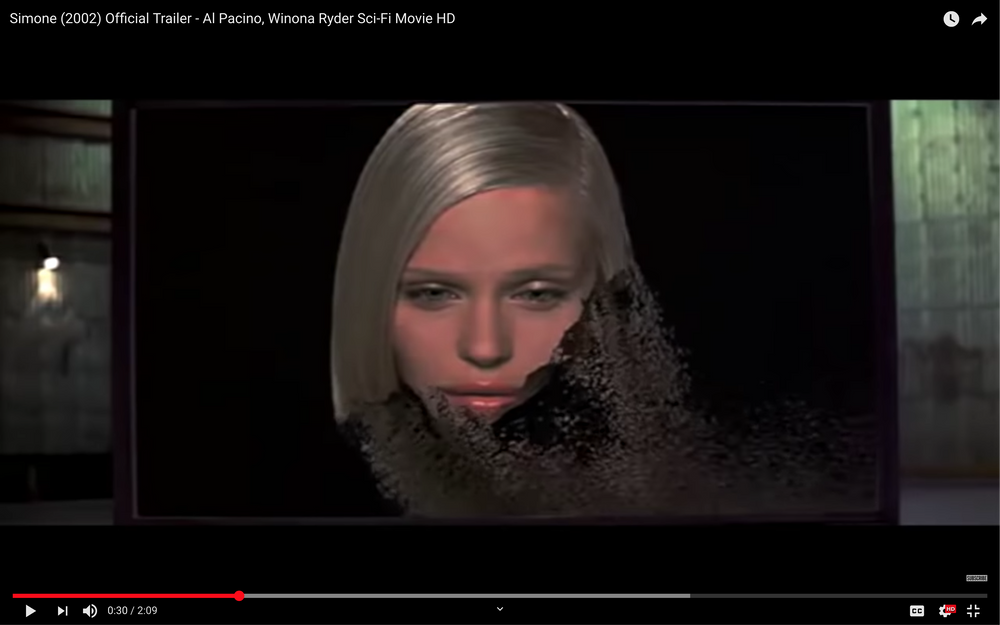Over the past decennia, the glitch art genre has grown up so much: glitch (and glitch art) is not just an aesthetic in digital art, glitch is in the world now.
I wrote the Glitch Moment(um) a little over 10 years ago. A main point then was that every form of glitch, either accidental or designed, will eventually become a new form or even a meaningful expression. Since then, digital technologies have reinforced their ubiquitous and pervasive presence. And with their ubiquity, artefacts such as cracked screens, broken images, colour channel shifts and other form of noise have become every day occurrences. In fact, everything seems to be littered with glitch. Glitches are on the flyer of my local falafel shop. They are in the commercials of my least favourite politicians. I can even deploy different types of glitches as a face filter on instagram. As a result, glitches have moved far away from being just a scary, or unexpected break; they are no longer just a moment of digital interruption - a moment when what lies ahead is unknown. The glitch is in the world now, not just as a digital event but also as a meaningful signifier; a figure of speech or a metaphor, with its own dialect and syntax. Just think about how in the movies, ghosts still announce their presence by adding analogue noise to a digital signals, or how blocky artifacts often signify a camera travelling through time. How lines and interlacing often describe an alien compromise of our telecommunication systems and how hackers still work in monochrome, green environments.
From its beginnings, glitch art used to exploit medium-reflexivity, to rhetorically question a ‘perfect’ use, or technological conventions and expectations. Artists adopted the glitch as a tool to question how computation shapes our everyday life. But today, distortions prompt the spectator to engage not only with the technology itself, but also with complex subcultural and meta-cultural narratives and gestures, presenting new analytical challenges. In short, the role of glitch in our daily lives has evolved and the glitch art genre has grown up.
But besides re-evaluating the study of glitch as a carrier of meaning, the glitch, or the digital accident, has also evolved on a fundamental level; in timing and space. Due to the networked nature of digital technologies, digital accidents are now decentralised; their cause and effects ripple through platforms, while the timing of these accident is no longer linear. The glitch no longer takes place as a linear sequence of events (interruption - glitch - debugging or collapse); and its interruptions do not happen momentarily, but instead as randomly timed pings inviting collapse or complexity anywhere the network reaches.
On the flip side, while the dominant, continuing search for a noiseless channel is still a regrettable, ill-fated dogma, we are filtering, suppressing and dismissing noise and glitch more widely than ever. As a result of this insight, I recently shifted my research to Resolution Studies. In a small new book, titled Beyond Resolution (2021), I describe the standardization of resolutions as a process that generally imposes efficiency, order and functionality on our technologies. But I also write that resolutions do not just involve the creation of protocols and solutions. They also entail the obfuscation of compromise and black-boxing of alternative possibilities, which as a result, are in danger of staying forever unseen or even forgotten. In this new book I deploy the glitch as a tool, for visiting and re-evaluating these compromises. I have experienced that while the glitch has evolved and changed, the glitch is still as powerful as a decade ago.
Glitch Art genre
As the popularization and cultivation of the glitch genre has now spread widely, I believe it is important to track the development of these processes in specific case studies and create ‘a lexicon of distortions’. New, fresh research within the field of noise artifacts is necessary. In an attempt to expand on A Vernacular of File Formats, I propose a lexicon that deconstructs the meanings of noise artifacts; a handbook to navigate glitch clichés as employed specifically in the genre of Sci-Fi.
This Lexicon intends to offer an insight into the development of meaning in the aesthetics of distortion in Sci-Fi movies throughout the years, via an analysis of 1200 Sci-Fi Trailers. Starting with trailers from 1998, I reviewed 30 trailers per year to obtain an insight into the development of noise artifacts in Sci-Fi from before the normalization of the home computer, to Sci-Fi adopting the contemporary aesthetics of our ubiquitous digital devices. My source for the trailers is the Internet Movie Database, where I accessed lists of the top-US Grossing Sci-Fi Titles per year. When watching these trailers I took screenshots whenever a distortion occured. Then, if possible, I would interpret them. Currently the database includes findings from research done into 630 trailers (1998-2018) but I wish to extend it to 1980-2020, spanning the 40 years of advancements in digital technologies and its distortions.
Sci-Fi relies on the literacy of the spectator (references to media technology texts, aesthetics and machinic processes) and their knowledge of more ‘conventional’ distortion or noise artifacts. Former disturbances have gained complex meaning beyond their technological value; with the help of popular culture, these effects have transformed into signifiers provoking affect. For example, analogue noise conjures up the sense of an eerie, invisible power entering the frame (a ghost), while blocky-artifacts often refer to time travelling or a data offense initiated by an Artificial Intelligence. Interlacing refers to an invisible camera, while camera interface esthetics (such as a viewfinders and tracking brackets or markers around a face) refer to observation technologies. Hackers still work in monochrome, green environments, while all holograms are made from phosphorous blue light. And when color channels distort, the protagonist is experiencing a loss of control.
︎Click on a year and see all the a/effect per trailer of that year!
I wrote the Glitch Moment(um) a little over 10 years ago. A main point then was that every form of glitch, either accidental or designed, will eventually become a new form or even a meaningful expression. Since then, digital technologies have reinforced their ubiquitous and pervasive presence. And with their ubiquity, artefacts such as cracked screens, broken images, colour channel shifts and other form of noise have become every day occurrences. In fact, everything seems to be littered with glitch. Glitches are on the flyer of my local falafel shop. They are in the commercials of my least favourite politicians. I can even deploy different types of glitches as a face filter on instagram. As a result, glitches have moved far away from being just a scary, or unexpected break; they are no longer just a moment of digital interruption - a moment when what lies ahead is unknown. The glitch is in the world now, not just as a digital event but also as a meaningful signifier; a figure of speech or a metaphor, with its own dialect and syntax. Just think about how in the movies, ghosts still announce their presence by adding analogue noise to a digital signals, or how blocky artifacts often signify a camera travelling through time. How lines and interlacing often describe an alien compromise of our telecommunication systems and how hackers still work in monochrome, green environments.
From its beginnings, glitch art used to exploit medium-reflexivity, to rhetorically question a ‘perfect’ use, or technological conventions and expectations. Artists adopted the glitch as a tool to question how computation shapes our everyday life. But today, distortions prompt the spectator to engage not only with the technology itself, but also with complex subcultural and meta-cultural narratives and gestures, presenting new analytical challenges. In short, the role of glitch in our daily lives has evolved and the glitch art genre has grown up.
But besides re-evaluating the study of glitch as a carrier of meaning, the glitch, or the digital accident, has also evolved on a fundamental level; in timing and space. Due to the networked nature of digital technologies, digital accidents are now decentralised; their cause and effects ripple through platforms, while the timing of these accident is no longer linear. The glitch no longer takes place as a linear sequence of events (interruption - glitch - debugging or collapse); and its interruptions do not happen momentarily, but instead as randomly timed pings inviting collapse or complexity anywhere the network reaches.
On the flip side, while the dominant, continuing search for a noiseless channel is still a regrettable, ill-fated dogma, we are filtering, suppressing and dismissing noise and glitch more widely than ever. As a result of this insight, I recently shifted my research to Resolution Studies. In a small new book, titled Beyond Resolution (2021), I describe the standardization of resolutions as a process that generally imposes efficiency, order and functionality on our technologies. But I also write that resolutions do not just involve the creation of protocols and solutions. They also entail the obfuscation of compromise and black-boxing of alternative possibilities, which as a result, are in danger of staying forever unseen or even forgotten. In this new book I deploy the glitch as a tool, for visiting and re-evaluating these compromises. I have experienced that while the glitch has evolved and changed, the glitch is still as powerful as a decade ago.
Glitch Art genre
As the popularization and cultivation of the glitch genre has now spread widely, I believe it is important to track the development of these processes in specific case studies and create ‘a lexicon of distortions’. New, fresh research within the field of noise artifacts is necessary. In an attempt to expand on A Vernacular of File Formats, I propose a lexicon that deconstructs the meanings of noise artifacts; a handbook to navigate glitch clichés as employed specifically in the genre of Sci-Fi.
This Lexicon intends to offer an insight into the development of meaning in the aesthetics of distortion in Sci-Fi movies throughout the years, via an analysis of 1200 Sci-Fi Trailers. Starting with trailers from 1998, I reviewed 30 trailers per year to obtain an insight into the development of noise artifacts in Sci-Fi from before the normalization of the home computer, to Sci-Fi adopting the contemporary aesthetics of our ubiquitous digital devices. My source for the trailers is the Internet Movie Database, where I accessed lists of the top-US Grossing Sci-Fi Titles per year. When watching these trailers I took screenshots whenever a distortion occured. Then, if possible, I would interpret them. Currently the database includes findings from research done into 630 trailers (1998-2018) but I wish to extend it to 1980-2020, spanning the 40 years of advancements in digital technologies and its distortions.
Sci-Fi relies on the literacy of the spectator (references to media technology texts, aesthetics and machinic processes) and their knowledge of more ‘conventional’ distortion or noise artifacts. Former disturbances have gained complex meaning beyond their technological value; with the help of popular culture, these effects have transformed into signifiers provoking affect. For example, analogue noise conjures up the sense of an eerie, invisible power entering the frame (a ghost), while blocky-artifacts often refer to time travelling or a data offense initiated by an Artificial Intelligence. Interlacing refers to an invisible camera, while camera interface esthetics (such as a viewfinders and tracking brackets or markers around a face) refer to observation technologies. Hackers still work in monochrome, green environments, while all holograms are made from phosphorous blue light. And when color channels distort, the protagonist is experiencing a loss of control.
︎Click on a year and see all the a/effect per trailer of that year!
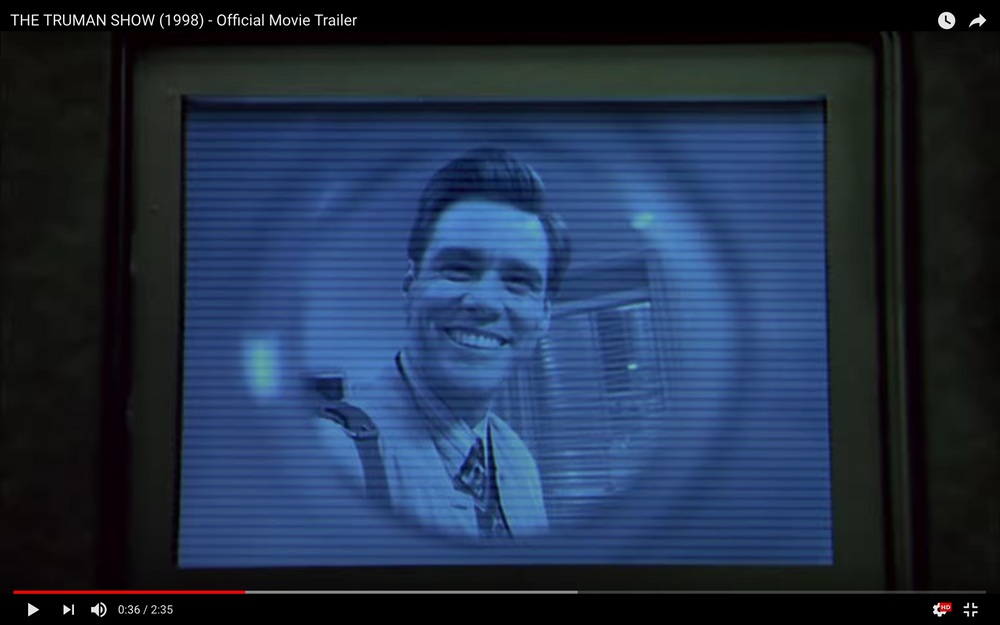 1998 - In the Truman Show, CCTVs secret observation cameras are outfitted with scanlines and vignetting.
1998 - In the Truman Show, CCTVs secret observation cameras are outfitted with scanlines and vignetting.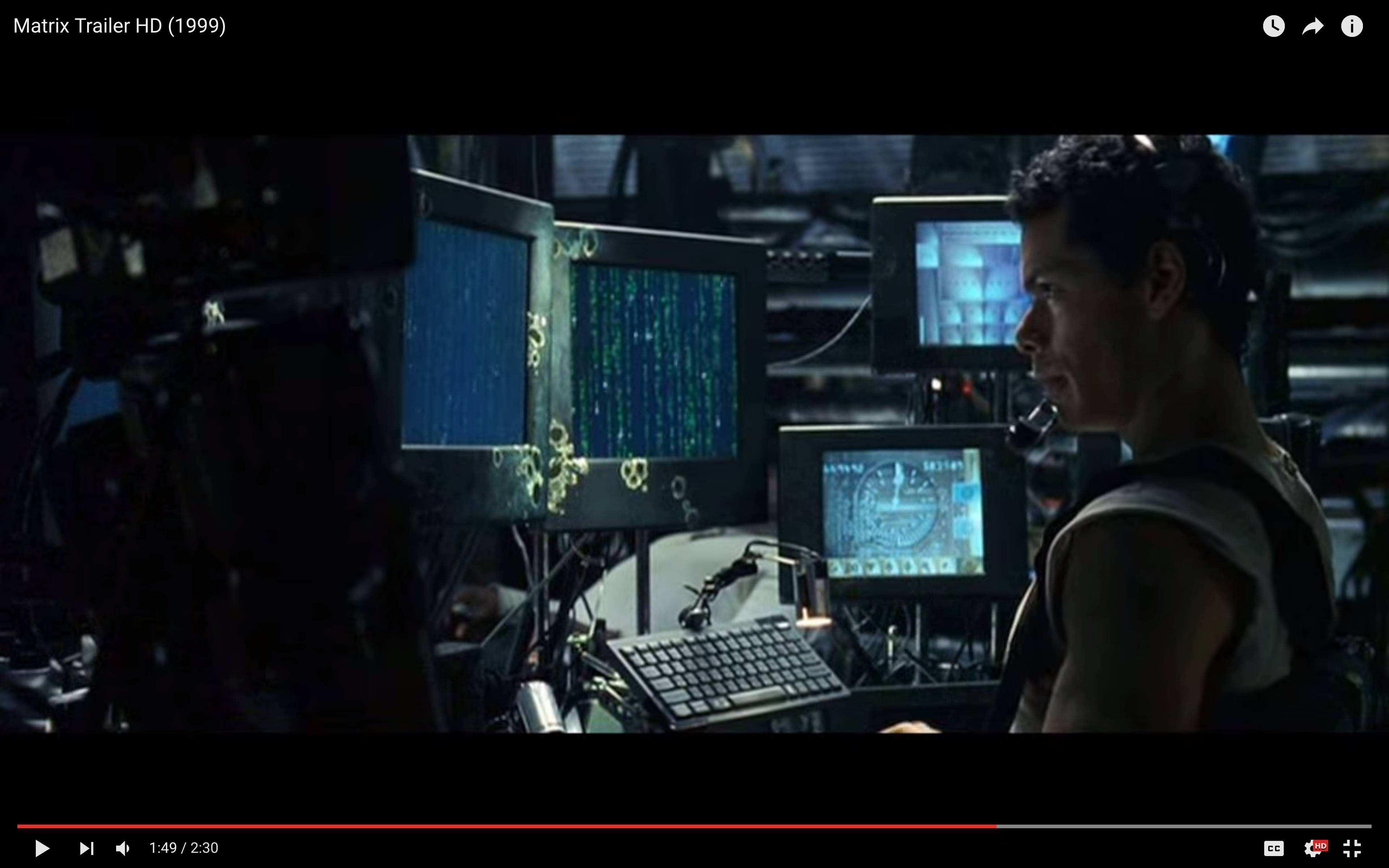 1999 - Unicode characters displayed as streams of monochrome, vertical data signify the hackers navigating ‘the Matrix’.
1999 - Unicode characters displayed as streams of monochrome, vertical data signify the hackers navigating ‘the Matrix’.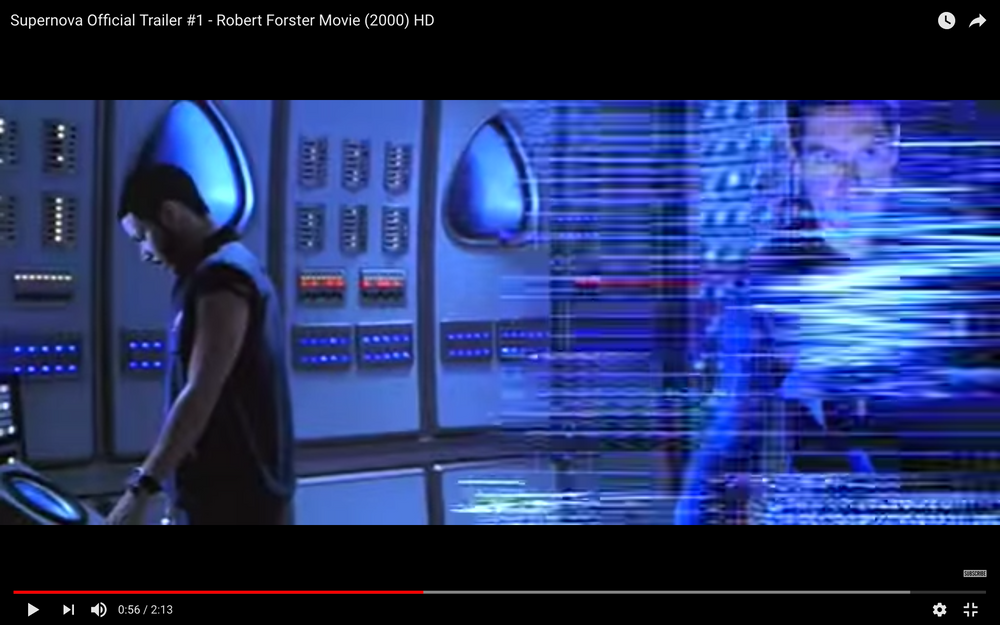 2000 - Sci fi screens feature a lot of blue because sets often use tungsten (warm) light. Filmmakers compensate for this in post processing, during which blue colors are effected the least, maintaining the vibrancy of other colors the best.
In this shot from Supernova, a critical SOS signal is received.
2000 - Sci fi screens feature a lot of blue because sets often use tungsten (warm) light. Filmmakers compensate for this in post processing, during which blue colors are effected the least, maintaining the vibrancy of other colors the best.
In this shot from Supernova, a critical SOS signal is received.
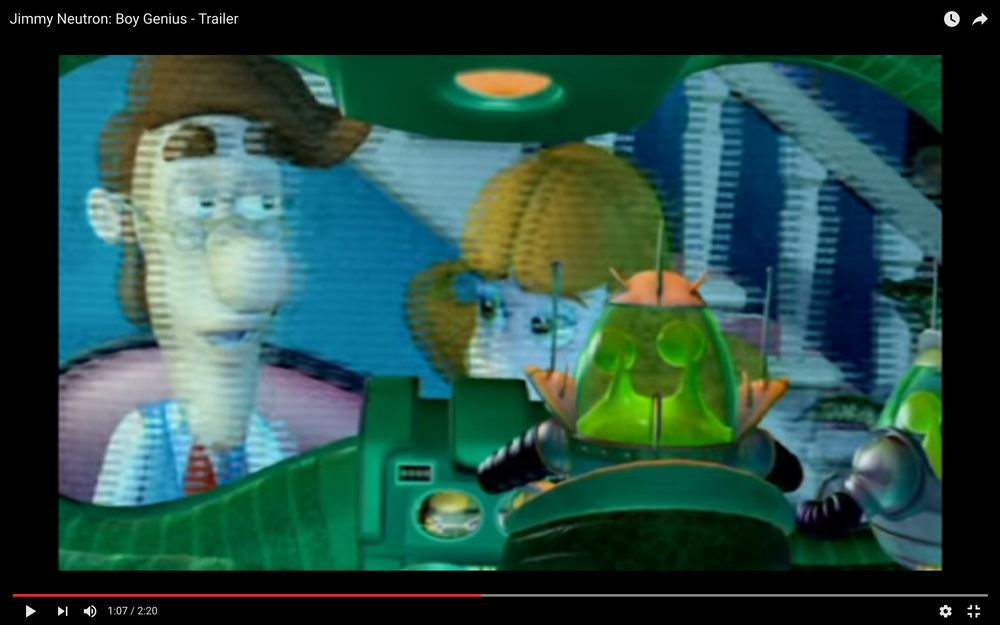 2001 - in Jimmy Neutron, an alien observes the parents. A voice over says: “The crummy aliens stole our parents”
2001 - in Jimmy Neutron, an alien observes the parents. A voice over says: “The crummy aliens stole our parents”
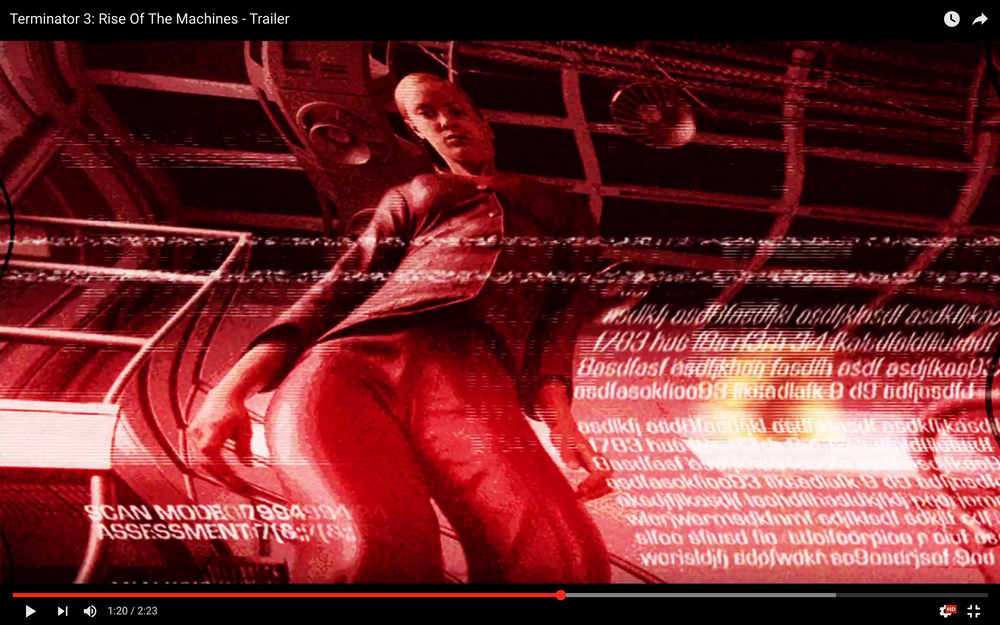 2003 - “The machines are starting to take over!” is uttered when T-X knocks out the terminator. A combination of what seems like digital and analogue, monochrome red distortions cover the ‘interface’ of the Terminators point of view as he goes down.
2003 - “The machines are starting to take over!” is uttered when T-X knocks out the terminator. A combination of what seems like digital and analogue, monochrome red distortions cover the ‘interface’ of the Terminators point of view as he goes down. 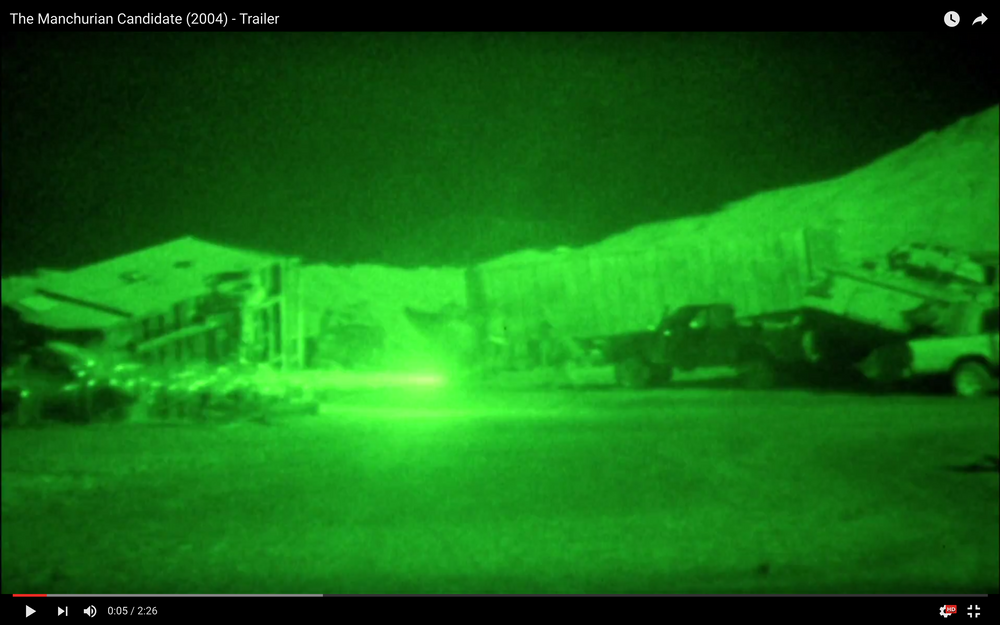 2004 - In The Manchurian Candidate, soldiers are kidnapped and brainwashed for sinister purposes. Some of the shots use military night vision equiplement.
2004 - In The Manchurian Candidate, soldiers are kidnapped and brainwashed for sinister purposes. Some of the shots use military night vision equiplement. 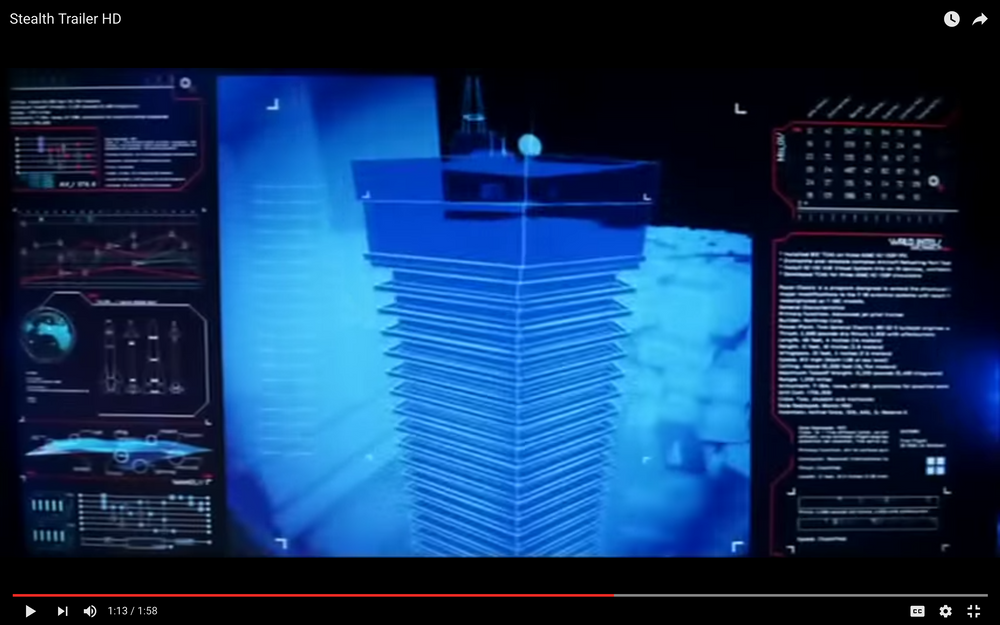 2005 - In Stealth, an artificial intelligence program has “rewired itself and chosen its own target”. Blue, phosphorous holograms are flanked by non understandable diagrams and information.
2005 - In Stealth, an artificial intelligence program has “rewired itself and chosen its own target”. Blue, phosphorous holograms are flanked by non understandable diagrams and information. 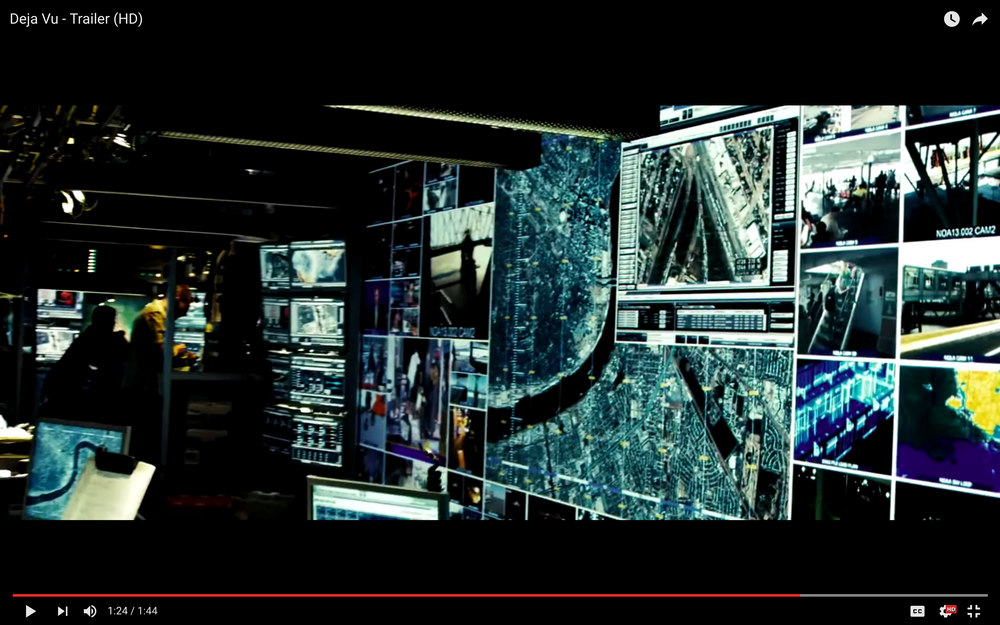 2006 -
‘experimental surveillance technology’ uses grid like, monochrome maps on top of maps in Deja Vu
2006 -
‘experimental surveillance technology’ uses grid like, monochrome maps on top of maps in Deja Vu 2007 - Umbrella Corp uses surveillance technology, which uses tracking brackets and facial markers to compare a target to an image file.
2007 - Umbrella Corp uses surveillance technology, which uses tracking brackets and facial markers to compare a target to an image file.
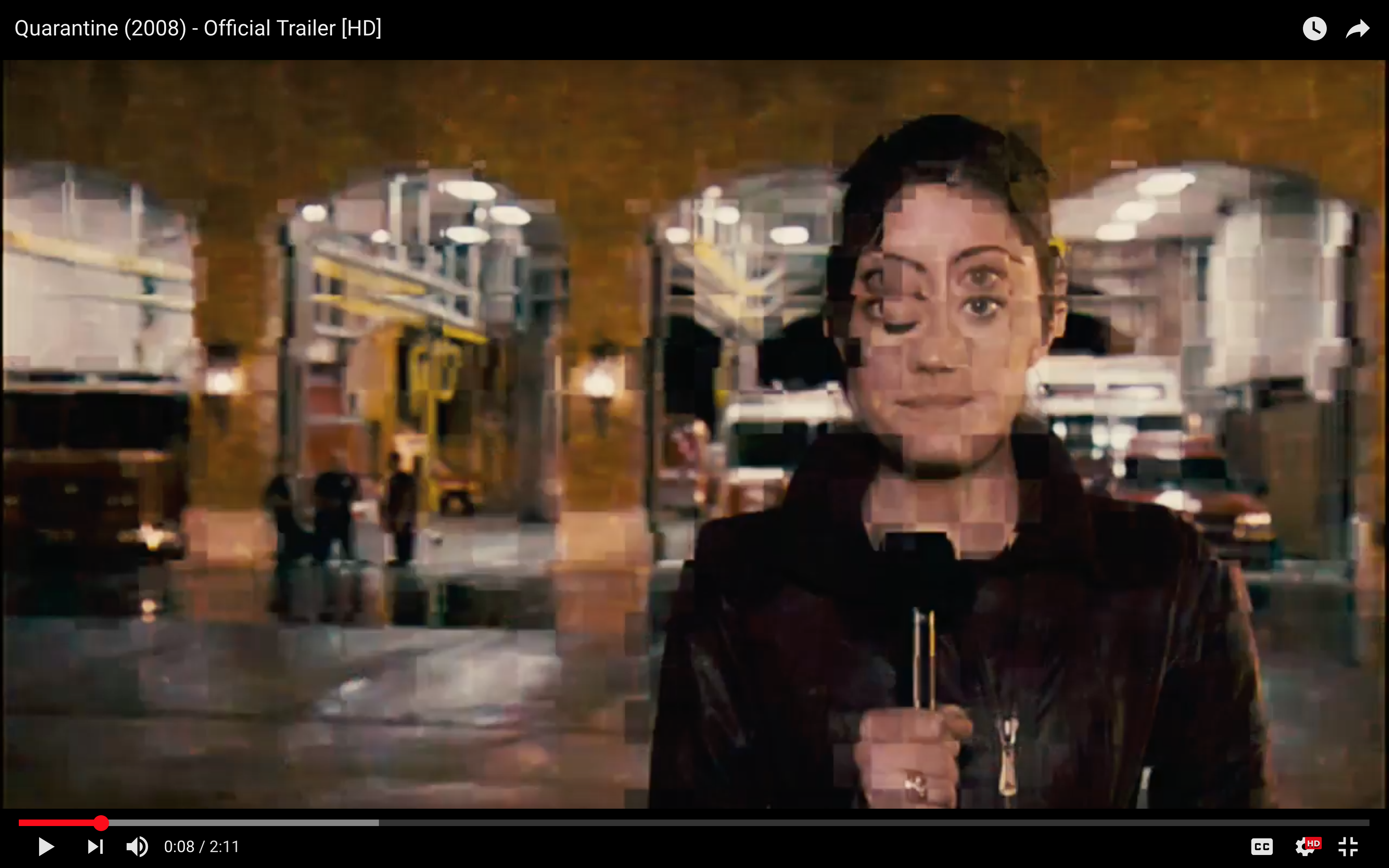 2008 - Interruptions in live television streams are no longer illustrated by analogue noise, but by macroblocking artifacts (referencing new .mp4 and streaming technologies) in Quarantine.
2008 - Interruptions in live television streams are no longer illustrated by analogue noise, but by macroblocking artifacts (referencing new .mp4 and streaming technologies) in Quarantine. 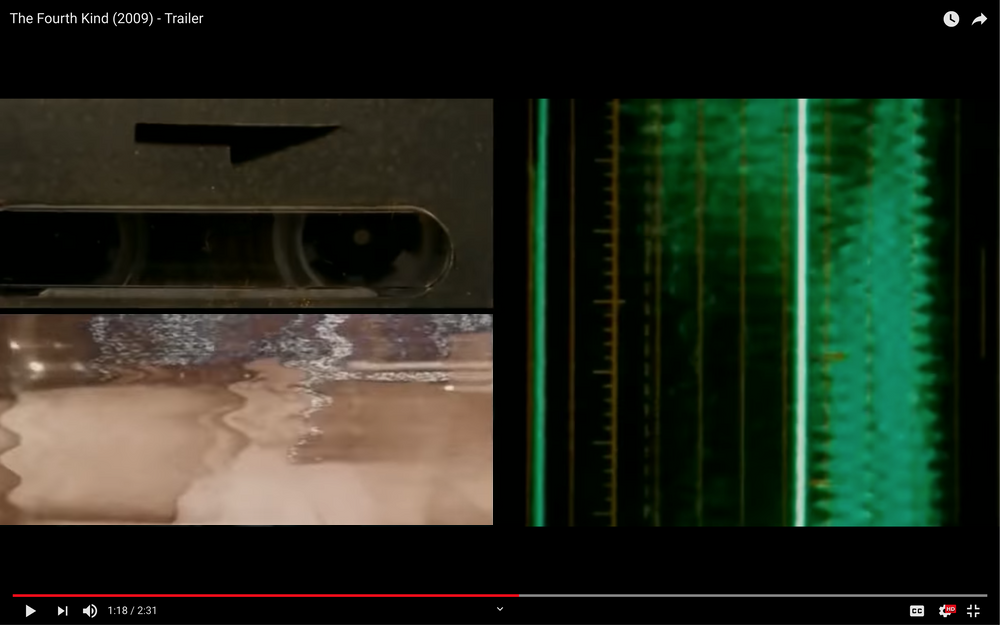 2009 - A fantastic year for glitch artifacts in sci fi, my favorite trailer is the Fourth Kind, which features monchrome EVP alongside analogue, wobbulating video registrations.
2009 - A fantastic year for glitch artifacts in sci fi, my favorite trailer is the Fourth Kind, which features monchrome EVP alongside analogue, wobbulating video registrations.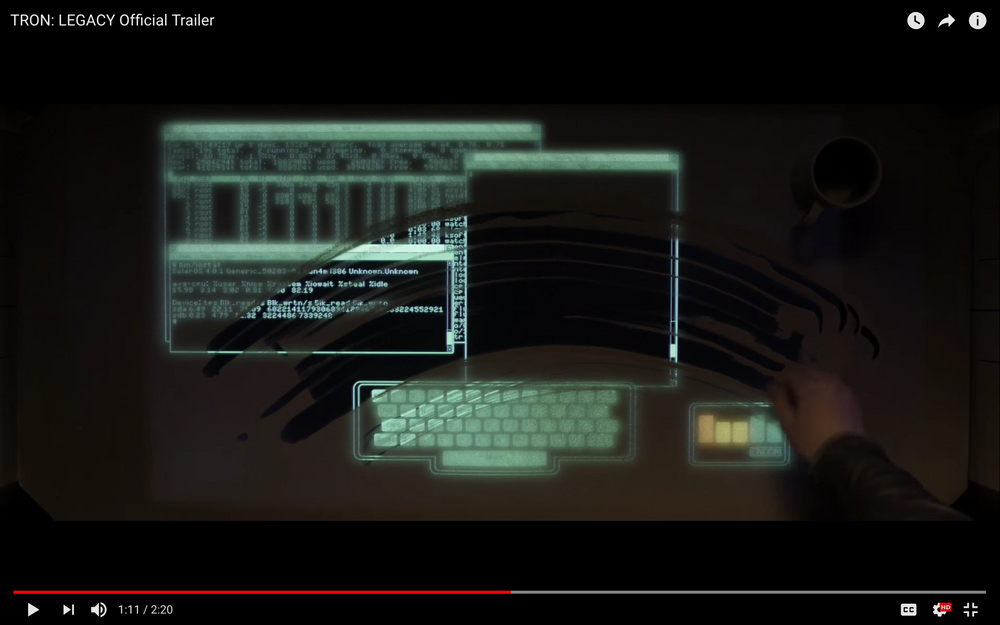 2010 - The good old text based, cyano green (old and hacker) console that functions as a portal to Tron.
2010 - The good old text based, cyano green (old and hacker) console that functions as a portal to Tron. 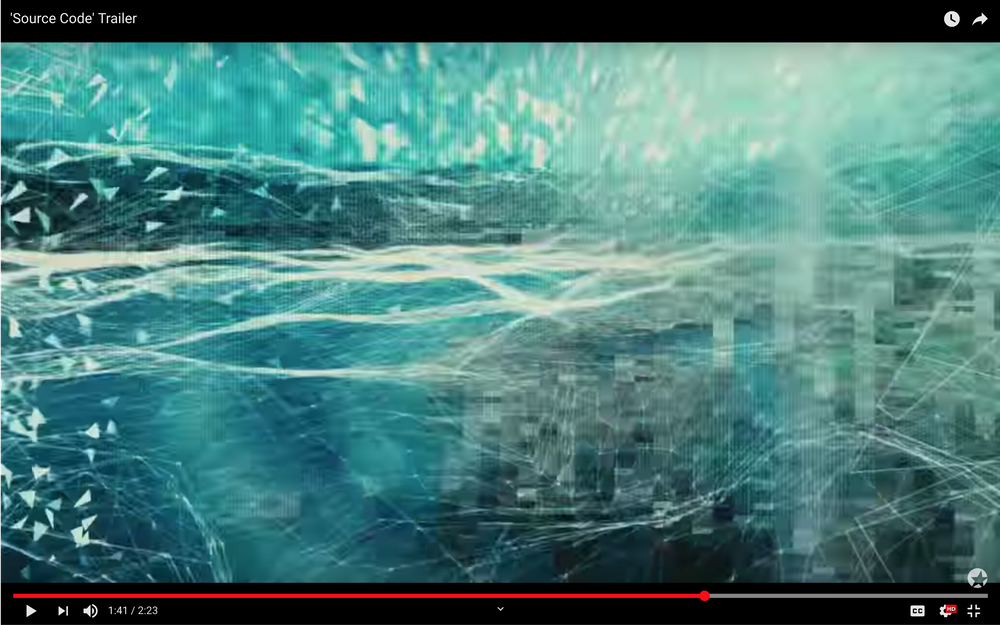 2011 - In Source code, a soldier can not only jump back in time but also into someone else's body. These jumps are always rough and confusing. Aesthetically, the jump look a body fell apart into little triangular vectors travelling a somewhat noisy, blocky [that must be the time shift] wire plane.
2011 - In Source code, a soldier can not only jump back in time but also into someone else's body. These jumps are always rough and confusing. Aesthetically, the jump look a body fell apart into little triangular vectors travelling a somewhat noisy, blocky [that must be the time shift] wire plane.
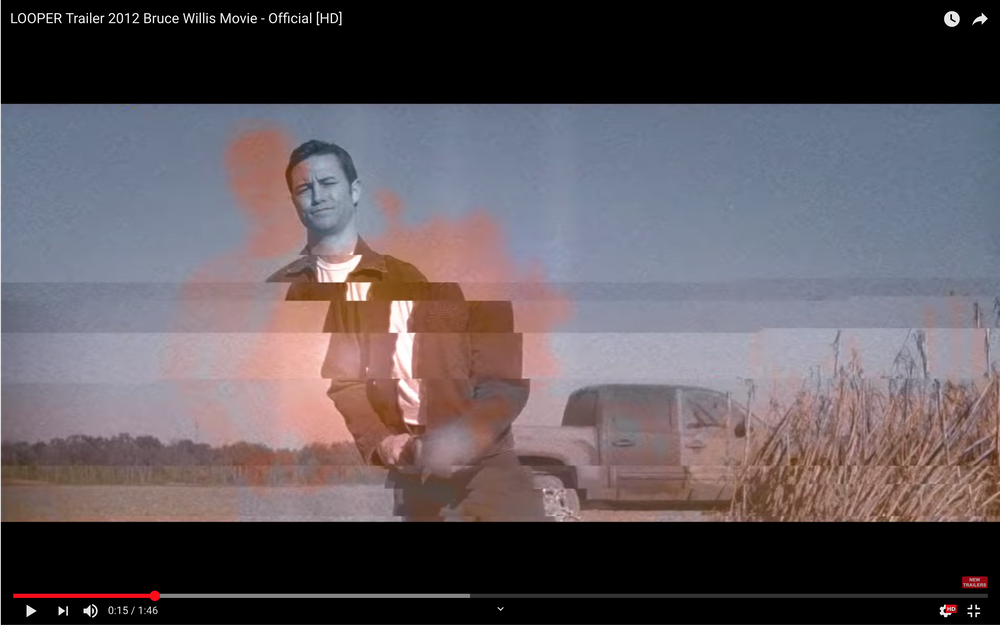 2012 - Looper is set in 2074. In this time, when the mob wants to get rid of someone, the target is sent into the past, where a hired gun awaits. Time jump problems are shown by a sliced image with ghosting colors.
2012 - Looper is set in 2074. In this time, when the mob wants to get rid of someone, the target is sent into the past, where a hired gun awaits. Time jump problems are shown by a sliced image with ghosting colors. 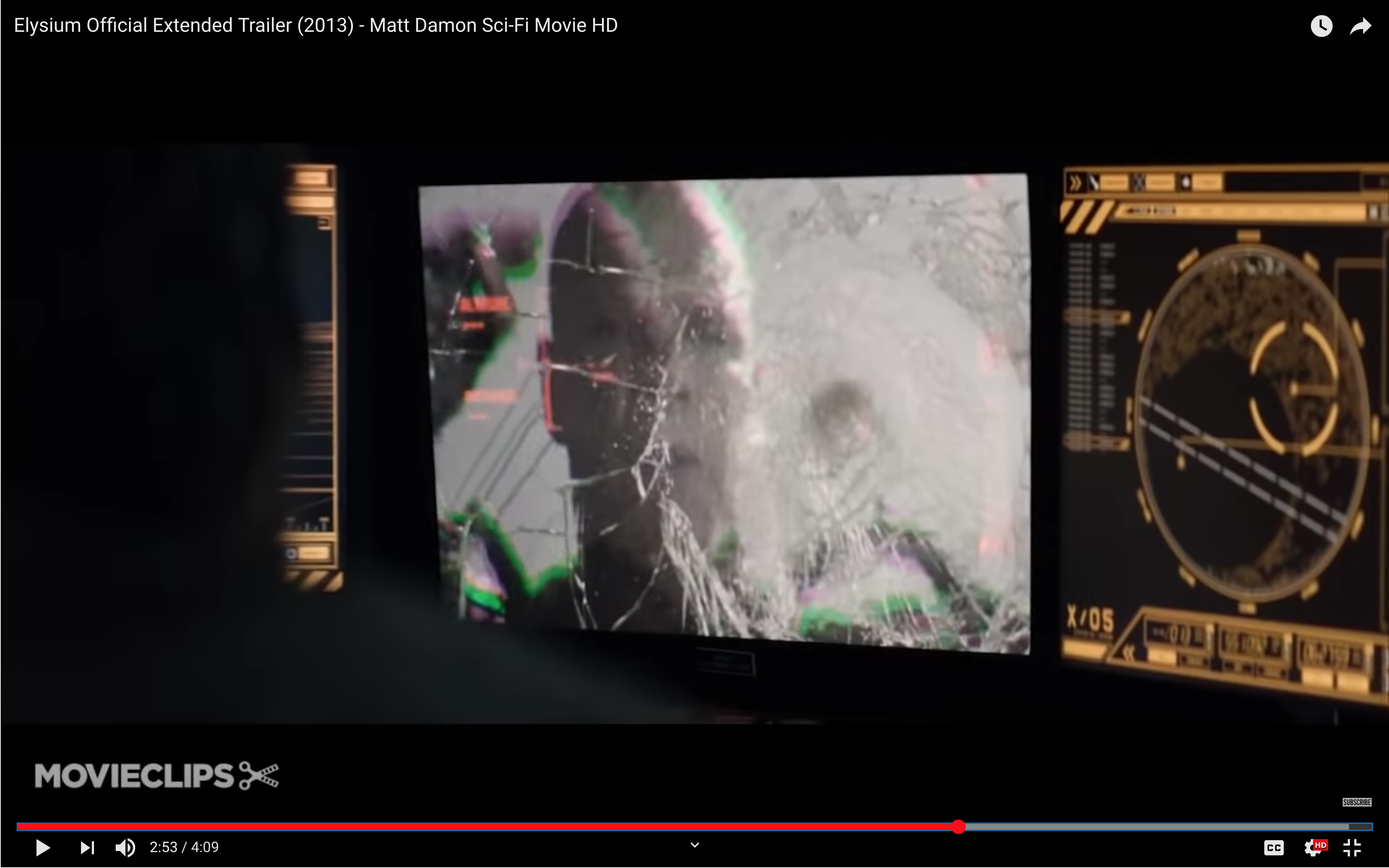 2013 - In Elysium, Max is observed through a broken monitor. It is so action packed, even the color channels are no longer properly aligned.
2013 - In Elysium, Max is observed through a broken monitor. It is so action packed, even the color channels are no longer properly aligned. 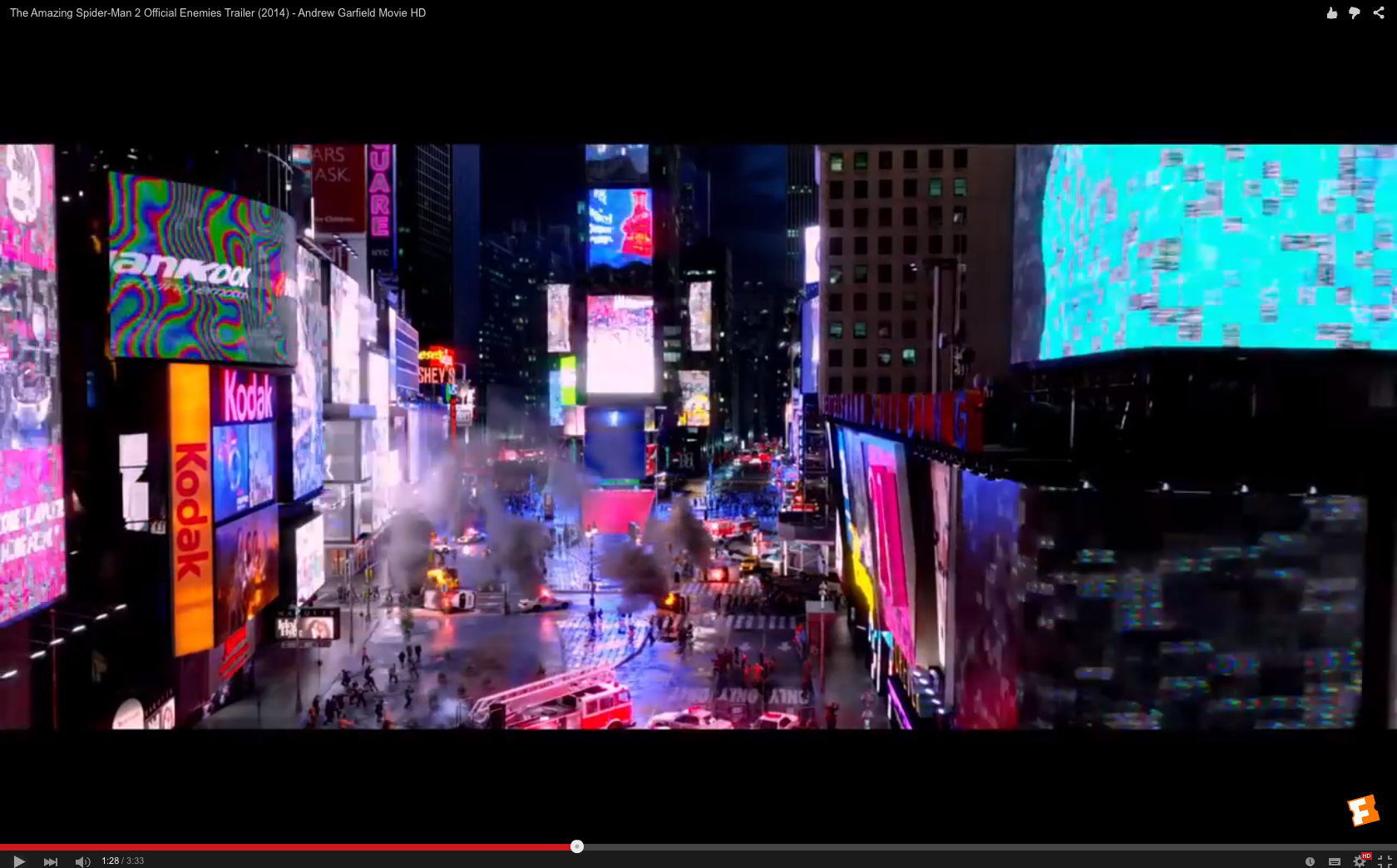 2014 - During a fighting scene between Electro, who has the ability to control electricity, and Spiderman, the billboards of Times Square go all glitchy. ÷ The Amazing Spider-Man™ 2 (2014) was shot on KODAK VISION3 Color Negative Film.
2014 - During a fighting scene between Electro, who has the ability to control electricity, and Spiderman, the billboards of Times Square go all glitchy. ÷ The Amazing Spider-Man™ 2 (2014) was shot on KODAK VISION3 Color Negative Film.
All the bill boards glitch and finally explode, while Kodak is the of the last billboards left standing.
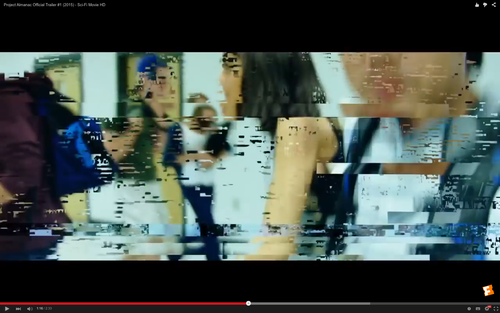 2015 - A group of teens discover secret plans of a time machine, and construct one. However, things start to get out of control. This is when blocking artifacts occur (similar to DV blocking when a tape is being FFWD).
2015 - A group of teens discover secret plans of a time machine, and construct one. However, things start to get out of control. This is when blocking artifacts occur (similar to DV blocking when a tape is being FFWD).  2016 - In Captain America, archival footage features very clean and clear (digital) scan lines.
2016 - In Captain America, archival footage features very clean and clear (digital) scan lines. 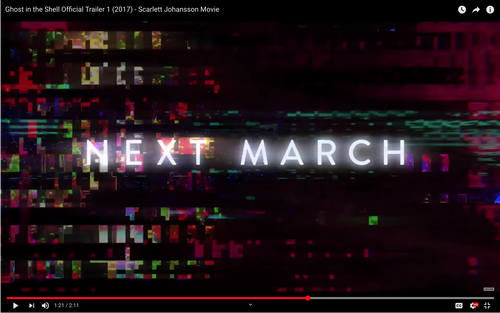 2017 was a very interesting year for noise artifacts. Several trailers use them very meaningfully. In the Ghost in the Shell, ‘noise’ is more complex than contemporary compression artifacts (combining color channels, blocks, lines and some structures that are not, as far as I can see, directly referencing any compression). This must signify the ghost, existing and developing as a very complex creature inside the networks.
2017 was a very interesting year for noise artifacts. Several trailers use them very meaningfully. In the Ghost in the Shell, ‘noise’ is more complex than contemporary compression artifacts (combining color channels, blocks, lines and some structures that are not, as far as I can see, directly referencing any compression). This must signify the ghost, existing and developing as a very complex creature inside the networks. 2018 - In Annihilation, a biologist is confronted with a mysterious zone where the laws of nature (and distortion) don't apply. Here destortions are not destroying something, but they are ‘making something new’.
2018 - In Annihilation, a biologist is confronted with a mysterious zone where the laws of nature (and distortion) don't apply. Here destortions are not destroying something, but they are ‘making something new’.